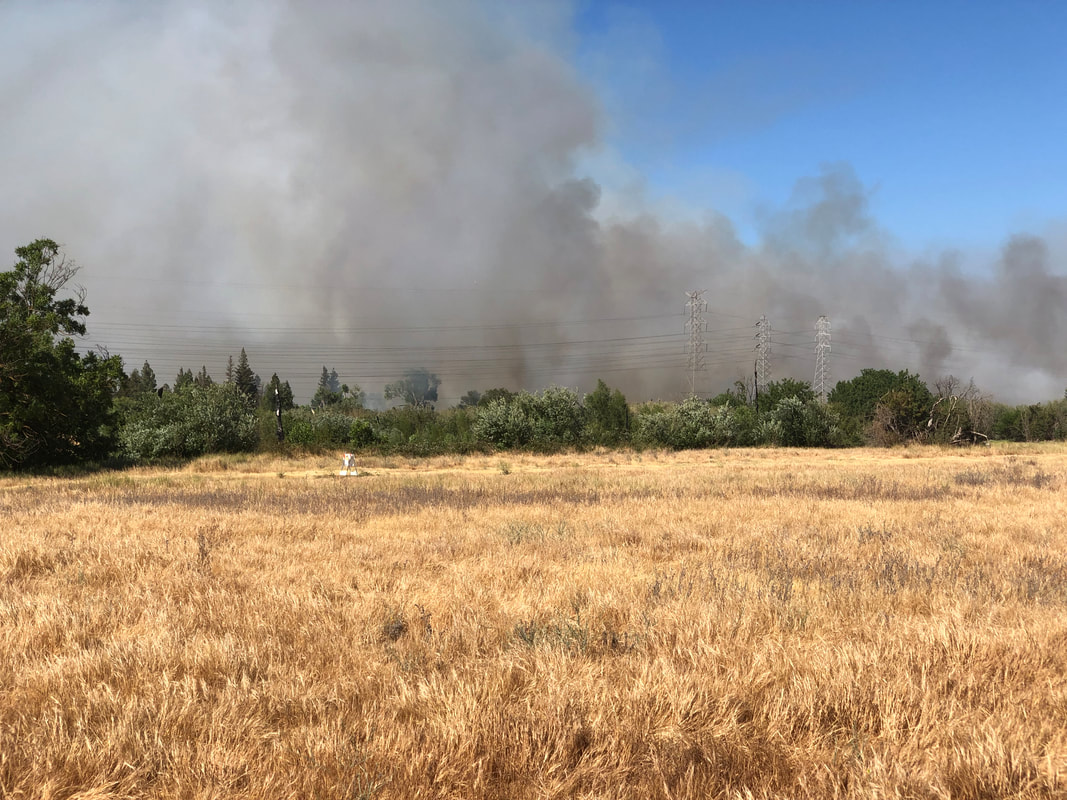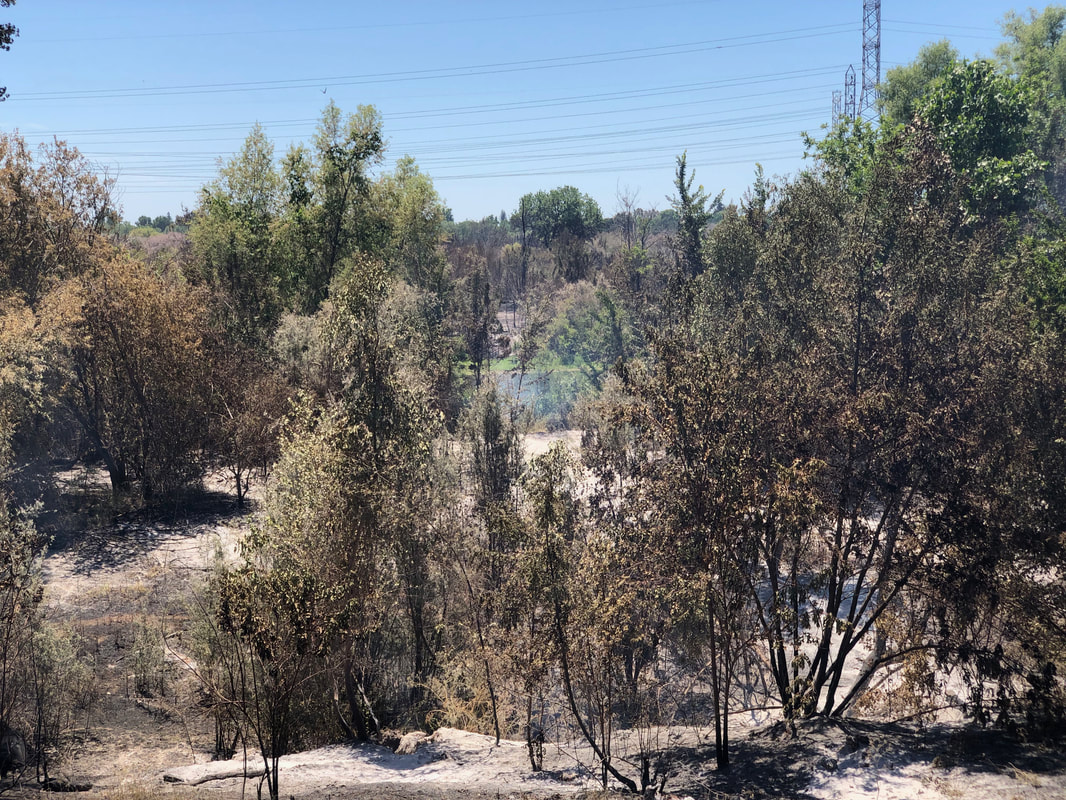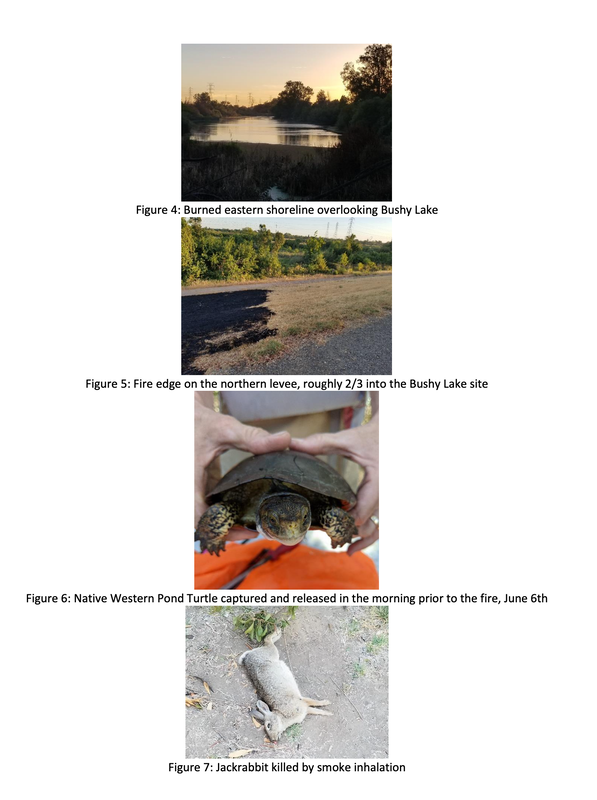There have been many fires already this year in the lower American River Parkway. This fire at Bushy Lake has been one of the worst so far. The latest fire burned for several days and has raised questions about fire management in the Parkway and best practices when responding in a Nature Study Area. A shared photo/video album is available with much more on the breadth and degree of impacts of the fire.
From: SUBJECT: June 6 Wildfire at Bushy Lake
Dr. Michelle Stevens, Bushy Lake Eco-Cultural Restoration Principal Investigator
On Sunday June 6, a team of scientists and student research assistants left Bushy Lake at 1:00 pm after conducting turtle catch-and-release research and nest surveys. At approximately 2:00 pm, a wildfire started at a human encampment on the east side of Bushy Lake. The fire burned to the eastern shore of Bushy Lake, burning all vegetation in its path. There was no discernible effort by fire crews to stop the progress of the “slow moving” fire toward the Bushy Lake Restoration Project (see Figure 1 and 2).
Sacramento State faculty and students have been conducting experimental plantings of fire resilient and culturally important native vegetation for the past five years (see Figure3). Over 600 students and community volunteers have been involved in planting, weeding, conducting experiments, and watering plants at the site. The wildfire destroyed the entire restoration effort. Previous fires occurred in 2014 (entirely destroyed the site, and when we began restoration work through the Earth Stewardship Initiative). Another fire occurred in 2016 and was stopped outside our experimental area on the south side of Bushy Lake.
What was the impact of this fire? The northeast side was burned from the Cal Expo levee to the water, the east side burned through our restoration project to the water, and I don’t yet know how much of the south side burned (see Figure 4 and 5). Turtles are nesting right now, with the females moving from the water to the upland to lay their eggs (see Figure 6). Besides destroying approximately six acres of planted native vegetation, we have recorded nesting western pond turtles, over 160 species of birds, resident deer and coyote and other wildlife species, Valley Elderberry Longhorn Beetle habitat and elderberry savanna, and over 50 species of butterflies and other pollinators (see Figure 7 impact on wildlife).
We will have an internal team meeting of scientists engaged on the project to determine our next steps. We will incorporate the “disturbance” into our study in order to make recommendations to inform our conceptual restoration plan, specifically in regards to fire resiliency. We have a number of questions to incorporate into our study after we have time to determine what is left and in what condition.
- 1) As soon as it is safe and the fire is out, we will continue nesting and population surveys on western pond turtles and non-native turtles;
a. Observation: did beaver presence and “beave way” construction on the site increase fire resilience?
b. Observation: will turtles use the burned areas for nesting sites? Will we find burned turtle nests in the burned areas?
c. Observation; will turtles depend more heavily on unburned areas of the site? - 2) We will monitor shifts in avian use of the site, determine bird use and nesting success, aquatic
biology and water quality post fire; - 3) We will monitor survival and revegetation of native plant species to determine fire resiliency;
- 4) When the rains come, we will replant the reference on-site restoration project with donations
and assistance from the stakeholder community;
I did not observe any attempt by the fire department to protect the natural resources at Bushy Lake. Why was no line dug to protect the restoration project from what is described as a “slow moving wildfire from the east”? Are natural resources designated as a state nature preserve or restoration site a priority to be protected when wildfires erupt? Is it time to create priorities for natural resources along the lower American River parkway to protect natural resources from wildfire?
Hundreds of thousands of dollars of taxpayer funding, hundreds of hours of faculty, student and community elbow grease, and a great deal of love from many stakeholders on the lower American River have gone into the Bushy Lake Restoration Site. We plan to continue our study to the best of our ability, and make use of this wildfire “stressor” to continue our research.
However, as we continue our work, I want to know there is some kind of policy safeguard against these anthropogenic wildfires and their constant threat to Bushy Lake and other areas along the American River.




 RSS Feed
RSS Feed
